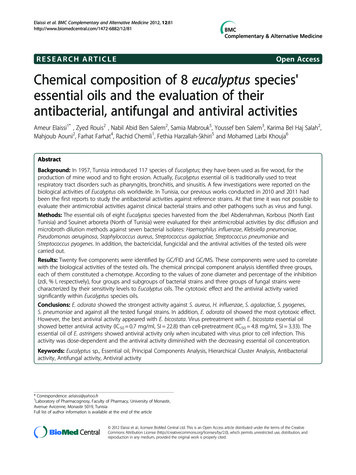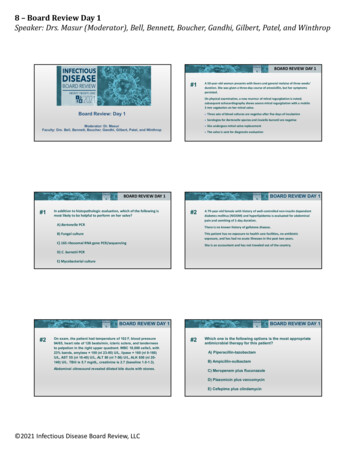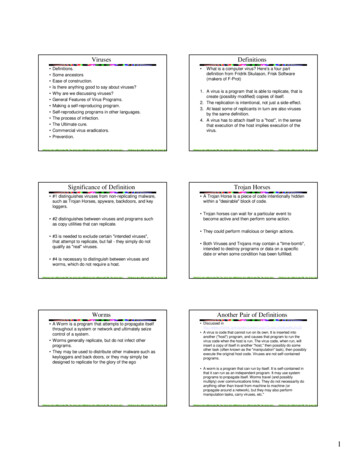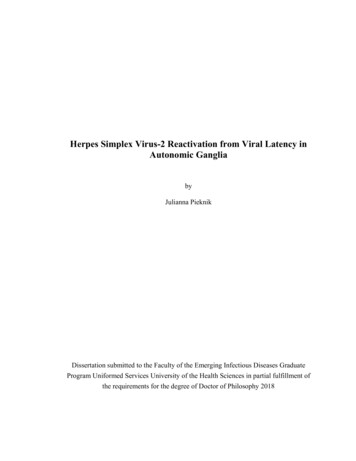
Transcription
Herpes Simplex Virus-2 Reactivation from Viral Latency inAutonomic GangliabyJulianna PieknikDissertation submitted to the Faculty of the Emerging Infectious Diseases GraduateProgram Uniformed Services University of the Health Sciences in partial fulfillment ofthe requirements for the degree of Doctor of Philosophy 2018
UNIFORMED SERVICES UNIVERSITY, SCHOOL OF MEDICINE GRADUATE PROGRAMSGraduate Education Office (A 1045), 4301 Jones Bridge Road, Bethesda, MD 20814FINAL EXAMINAnONIPRIVA TE DEFENSE FOR THE DEGREE OF IXX.:'TOROF PHILOSOPHYIN THE EMERGING INFEcrlOUS DISEASES GRADUATE PROGRAMName of Student: Julianna PieknikDate of Examination: Monday. Maoch 26.2018Time: roo PMPlace: Room A2052DECISION OF EXAMINAnON COMMITTEE MEMBERS:PASSFAIL""'lIaJ llil.BVSc. MS. PhDOF MICROBIOLOGY & IMMUNOLOGYMD. CAPT. USPHSNT OF EMERGING INFECTIOUS DISEASEDissertation Advisorch()t; iam.PhDDEPARTMENT OF MICROBIOLOGY & IMMUNOLOGYCommittee Memberndrew L. Snow. PhDDEPARTMENT OF PHARMACOLOGYCommittee MemberJ.n Lees. PhDPARTMENT OF MEDICINECommittee MemberGregory P Mueller, Ph.D.,Associate Deanwww.usuhs.mil/graded i graduateprogram@usuhs.eduToll Free: 800-772-1747 i Commercial: 301-295-3913 / 9474DSN:295-9474Fax: 301-295-6772
UNIFORMED SERVICES UNIVERSITY, SCHOOL OF MEDICINE GRADUATE PROGRAMSGraduate Education Office (A 1045), 4301 Jones Bridge Road, Bethesda, MD 20814APPROVAL OF THE DOCTORAL DISSERTATION IN THE EMERGING INFECfIOUSGRADUATE PROGRAMDISEASESTitle of Dissertation: "Herpes Simplex Virus-2 Reactivation from Viral Latency in Autonomic Ganglia"Name of Candidate:Julianna PieknikDoctor of PhilosophyMarch 26.2018DISSERTATION AND ABSTRACfAPPROVED:DATE:VSc. MS. PhDMICROBIOLOGY& IMMUNOLOGYDissertation AdvisorChou-Zen Giam. PhDDEPARTMENT OF MICROBIOLOGYCommittee Member& IMMUNOLOGYtVHd ewL. Snow. PhDDEPARTMENT OF PHARMACOLOGYCommittee MemberJa'\O .DE ARTMENT OF MEDICINECoMmittee MemberGregory P. Mueller, Ph.D.,Associate Deanwww.u5uhs.mil/graded I graduateprogram@usuhs.eduToll Free: 800-772-1747 i Commercial: 301-295-3913/9474 Ii DSN:295-9474 ii Fax: 301-295-6772
ACKNOWLEDGMENTSI would like to thank my mentor, Dr. Phil Krause for his patience, guidance andsupport, Amita Patel for teaching me the art of cloning and cell culture, and Shuang Tangfor tough critique that constantly challenged the rigor of my work. I also appreciate thehelpful feedback from my esteemed thesis committee, allowing me to transform data intocoherent knowledge. I would also like to thank Allen C. Myers for helping me discoverthe anatomical location of the ganglia, Camille Lake for key tricks in the art ofcryosectioning, Kaz Takeda for assistance with confocal microscopy, and Dr. Jill Ascher,Dr. Jessica Dewar and Moya Getrouw who provided key collaboration with the countlessguinea pigs. Without my fellow classmates, particularly Chelsi Beauregard, ClaireCostenoble-Caherty, Kasandra Hunter, Sofia Da Silva and Caitlin Williams, completingthe first two years would have been insurmountable. To my District Karaoke Team,Singles Tracking-especially Meg Massey and Amelia Shister, the relief and joy the hobbybrought me kept me sane. Their countenance was invaluable. Lastly, I would like tothank my family who has been my source of strength.iii
DEDICATIONFor my mother and father, I am truly blessed to be your daughter.iv
COPYRIGHT STATEMENTThe author hereby certifies that the use of any copyrighted material in the dissertationmanuscript entitled: "Herpes Simplex Virus-2 Reactivation from Viral Latency inAutonomic Ganglia" is appropriately acknowledged and, beyond brief excerpts, is withthe permission of the copyright owner.[signature]Julianna Pieknikv
ABSTRACTTitle of Dissertation:Herpes Simplex Virus-2 Reactivation from Viral Latency in Autonomic GangliaJulianna R. Pieknik, Doctor of Philosophy, 2018Thesis directed by:Philip R Krause, M.D., Deputy Director, Food and Drug Administration Office ofMedical Products and Tobacco Center for Biologics Evaluation and Research Office ofVaccines Research and Review and Professor, Department of Microbiology andImmunology, USUHSHerpes Simplex Virus-2 is a worldwide, major human pathogen that causesrecurrent disease over the lifetime of its host. According to current dogma, HSV-2reactivation occurs from the sensory, sacral dorsal root ganglia. However, a growingbody of evidence reports the virus latent in another branch of the peripheral nervoussystem, the autonomic ganglia. It is unclear whether spontaneous reactivation isoccurring in these additional sites, potentially contributing to recurrent genital skinlesions and observed clinical symptoms like urinary retention or responsible forsubclinical reactivations in the dermis.Due to the small size of virions and the rare spontaneous event of reactivation, afluorescent herpes simplex virus is an invaluable tool for localizing virus in cells.Unfortunately, available fluorescent mutants lack the required sufficient genetic stabilityvi
or normal kinetics of replication and reactivation. We hypothesized that by using abrighter, non-dimerizing fluorescent protein, we could engineer a functional mutant virusto begin to address some of the key questions related to reactivation of HSV-2. Weconstructed a fluorescent HSV-2 strain by fusing the fluorescent mNeonGreen protein tothe VP26 minor capsid protein. This mutant virus displayed normal replication and invivo recurrence phenotypes, providing an improved tool for investigating reactivationfrom latency.In order to explore the full extent of the tropism of reactivation we used theguinea pig vaginal infection model that develops spontaneous recurrent genital skinlesions and signs of autonomic dysfunction in the form of urinary retention andconstipation. Examining three anatomical locations: the sensory dorsal root ganglia(DRG), the mixed population of parasympathetic and sympathetic neurons of the majorpelvic ganglia (MPG) and the sacral sympathetic ganglia (SSG) by ex vivo explantation,we discovered that HSV-2 is not only latent, but its reactivation can be induced from theDRG and the SSG. Upon fluorescently labelling cryosections, we observed signs of invivo reactivation within the DRG and SSG. We further validated our observations byusing Droplet Digital Reverse Transcriptase Polymerase Chain Reaction (ddRT-PCR) toquantify gene expression. Our findings elevate the significance of autonomic neurons inHSV pathogenesis and suggest the sacral sympathetic ganglia could be important sites ofviral reactivation in the presence and absence of lesions.vii
TABLE OF CONTENTSACKNOWLEDGMENTSIIIDEDICATIONIVCOPYRIGHT STATEMENTVABSTRACTVILIST OF TABLESXILIST OF FIGURESXIICHAPTER 1: INTRODUCTION1INTRODUCTION TO HERPES SIMPLEX VIRUS 21Taxonomy, Genome and Structure1Immune Evasion2Prevalence and Incidence3Clinical Disease and Transmission4Co-infections5Treatment6HSV-2 LIFE n11viii
MODELS12In vitro, ex vivo12In vivo13Mouse Model14Rabbit Model15Nonhuman Primate Model15Guinea Pig Model15THE NERVOUS SYSTEM16FLUORESCENT PROTEIN SELECTION AND PLACEMENT24GOAL AND SPECIFIC AIMS25CHAPTER 2: A VP26-MNEONGREEN CAPSID FUSION HSV-2 MUTANTREACTIVATES FROM VIRAL LATENCY IN THE GUINEA PIG GENITALMODEL WITH NORMAL 35Supplemental Figures52Discussion57Acknowledgements58Author Contributions59CHAPTER 3: HSV-2 REACTIVATES SPONTANEOUSLY FROM LATENCY INAUTONOMIC 7ix
Figures71Supplemental Figures87Discussion93Acknowledgements96Author Contributions97CHAPTER 4: RESULT SUMMARY, CONCLUSIONS, SIGNIFICANCE ANDFUTURE DIRECTIONS98Result summary from chapter two98Chapter two significance100Result summary from chapter three100Chapter 3 significance and future directions102Appendix A. Major Pelvic Ganglia Data105Appendix B. Relative Expression109REFERENCES113x
LIST OF TABLESTable 1. Scoring System for Genital Diseasexi21
LIST OF FIGURESFigure 1. Adapted from Global Estimates of Prevalent and Incident Herpes Simplex Virus Type 2Infections in 2012. PLoS ONE 10(1): e114989. https://doi.org/10.1371 journal.pone.0114989,copyright (2015) Permission not required as per Creative Commons Attribution (CC BY)license https://creativecommons.org/licenses/by/4.0/. . 4Figure 2. Guinea Pig Dorsal Root Ganglion nestled in an orifice in the spine that has been cut in halfacross the sagittal plane with the spinal cord removed. . 17Figure 3. The MPG of a male rat. Adapted from: Functional and molecular changes of the bladder inrats with crushing injury of nerve bundles from major pelvic ganglion to the bladder: role ofRhoA/Rho kinase pathway. Kim SJ, Lee DS, Bae WJ, Kim S, Hong SH, Lee JY, Hwang TK,Kim SW - Open Access Int J Mol Sci (2013). 1996-2018 MDPI (Basel, y/4.0/. . 18Figure 4. The location of the Bladder and MPG in a female guinea pig. 19Figure 5. Location of the Paracervical Ganglia in a Female Guinea Pig. Adapted from Source: DruryReavill, DVM, DABVP (Avian Practice), DACVP ics/. . 20Figure 6. The location of the Sacral Sympathetic Ganglia in a female guinea pig.) . 22Figure 7. Western blot, stained with anti-VP26, indicating that in Nedel, VP26 is fused tomNeonGreen. Vero cells were harvested 24 hours after infection at an MOI of 10 with eitherStrain 333 or Nedel. Magic Marker protein standards, uninfected Vero cells, HSV-2 Strain 333infected Vero cells and Nedel-infected Vero cells are in the lanes left to right. . 40Figure 8. In Nedel-infected cells, mNeonGreen co-localizes with HSV antigen, and Nedel plaques aresimilar to wild-type. (A) Representative confocal image of a Nedel plaque. Nuclei (upper left)are stained with DAPI, mNeonGreen is detected (upper right) by fluorescence, and HSV-2antigens are detected by immunofluorescent staining using a polyclonal HSV-2 antibody (lowerleft). Merged image is shown at lower right. Enlarged images taken from the plaque (B)Intranuclear ,(C) Cytoplasmic (D) and proximal outer-membrane (E) with intense colocalization obscuring fluorescent pattern.(F) Plaque size comparison, mean of 20 plaques,Error bars reflect SEM, Unpaired two-tailed t test p 0.8216. . 42Figure 9. Nedel-infected primary murine neurons. mNeonGreen is detected within IB4-labeledneurons. Nedel replicates in IB4 sensory dorsal root ganglia neurons, as described previouslyfor wild type Strain 333(12). . 43Figure 10. Replication of Nedel in vitro.( A) Growth Curves of Strain 333 and Nedel in Vero Cells.Data points are the mean of three separate titrations and error bars reflect 95% confidenceintervals. Significance determined by Mann-Whitney U test, p 0.8983. (B) Epoxy-ResinEmbedding Transmission Electron Microscopic images of Nedel and Strain 333 in Vero cells. 45Figure 11. Characterization of Nedel in the guinea pig genital model of HSV infection (n 7 Strain333, n 13 Nedel ) (A) Acute Severity determined by genital lesion scoring on a scale from 0-4.Error bars represent SEM. Significance determined by two-way ANOVA, p 0.868 (B) Meancumulative number of recurrent genital skin lesions per guinea pig. Mean recurrencephenotype was determined by observing genital skin for new lesions. Error bars representstandard error of the mean. (Two-way ANOVA, p 0.932 *Vaginal swabs with subsequentplaque assay on days 4 and 7: 13/13 Nedel-infected animals and 7/7 Strain 333-infected animalsyielded 100% green and non-fluorescent plaques respectively. Day 14, 0% animals sheddingdetectable virus. Days 21 and 31, 2/13 of the Nedel-infected and 1/7 Strain 333-infected animalsyielded 100% green plaques. . 47Figure 12. Ex Vivo Reactivation from explanted Sacral Dorsal Root Ganglia. Fluorescent images ofenzymatically dissociated sensory neurons from guinea pigs 36 days post-infection and 72 hourspost-plating with either (A) Strain 333 or (B) Nedel. Upper left: Detection of mNeonGreenfluorescence, Upper right: immunofluorescence using pAb HSV-2-AF546, Lower left: PanNeuronal stain, Lower right quadrant: Merged. Explant with (C) enlarged field of view withphase contrast, DAPI and a pan-neuronal stain. (D) Confocal image of explant with stainingstrategy used in A and B. 50xii
Figure 13. In Vivo Reactivation. Representative confocal microscopic images of immunolabelledcryosections of guinea pig sacral dorsal root ganglia (A) Strain 333 (B) Nedel. Upper left:Detection of mNeonGreen fluorescence, Upper right: immunofluorescence using pAb HSV-2AF546, Lower left: Pan-Neuronal stain, Lower right: Merged. (C) Enlarged image ofreactivation seen in B. (D,E) Additional neurons showing similar fluorescent spatial overlap,likely representing in vivo viral reactivation. . 51Figure 14. All Animals included in overall clinical score of genital skin. . 52Figure 15. Confocal microscopic image of DRG explantation from Strain-333-infected animals.Control for pAb HSV-2-AF546, showing no bleed over into GFP channel. . 53Figure 16. Low Magnification of fluorescence emerging 60 hours post-plating, pre-staining. . 54Figure 17. DAPI and Pan-Neuronal Stain only, Nedel-Infected DRG. Parameters showing greenfluorescence does not bleed into AF546 channel. . 55Figure 18. DAPI and Pan-Neuronal stain only, Strain 333-Infected. Parameters used to distinguishbackground levels or autofluorescence for confocal microscopy. . 56Figure 19. Ganglia Explantation: Representative images of in vivo Nedel-infected, dissociated andexplanted (A) Sensory Dorsal Root Ganglia (B) Expanded image of VP26-mNeonGreen from A(DRG) (C) Sacral Sympathetic Ganglia (SSG) (D) Expanded image of VP26-mNeonGreen fromC. Upper left: Detection of mNeonGreen fluorescence, Upper right: immunofluorescence usingpAb HSV-2-AF546, Lower left: Pan-Neuronal stain, Lower right quadrant: Merged . 74Figure 20. In vivo reactivation. Confocal images of immunolabelled, Nedel-infected frozen tissuesection of the (A) DRG and (B) Expanded Merged A; Upper left: Detection of mNeonGreenfluorescence, Upper right: immunofluorescence using pAb HSV-2-AF546, Lower left: PanNeuronal stain Lower right quadrant: Merged. Arrows point to cells exhibiting fluorescentcapsid and anti-HSV-2 pAb. . 76Figure 21. In vivo reactivation. Confocal images of immunolabelled, Nedel-infected frozen tissuesection of the (A) SSG and (B) Expanded Merged A; Upper left: Detection of mNeonGreenfluorescence, Upper right: immunofluorescence using pAb HSV-2-AF546, Lower left: PanNeuronal stain Lower right quadrant: Merged. Arrows point to cells exhibiting fluorescentcapsid and anti-HSV-2 pAb. Red bar 50um. . 78Figure 22. Latency Associated Transcript Gene Expression. (A) Raw copy number per individualAnimal in the DRG and SSG. (B) Summary of Animals’ LAT expression. (n 20) MannWhitney test, p 0.0032. . 80Figure 23. Summary of all animals’gene expression from the DRG and SSG.(A) ICP0 MannWhitney T test, P value 0.0024 (B)TK, P value 0.0011 . 82Figure 24. Gene Expression as it relates to abundance of LAT expression. (A) ICP0 (B) TK (C) gD 86Figure 25. Unstained Sacral Sympathetic Ganglia Explantation at low magnification, 48 hours postplating. . 87Figure 26. Unstained Sacral Sympathetic Ganglia Explantation at low magnification, 48 hours postplating. . 88Figure 27. True Black stained Sacral Sympathetic Ganglia Explantation 72 hours post-plating . 89Figure 28. Cryosection of the SSG, single stain, pan-neuronal AF594. A) Large field of view (B)Magnified selection from A. . 90Figure 29. Confocal image of Nedel-infected sacral sympathetic ganglia with HSV-2 pAb and DAPI. 92Figure 30. Fluorescence emergence, MPG explantation, unstained 48 hours post-plating. Phasecontrast overlay and GFP filter settings. . 106Figure 31. Fluorescence microscopic image of the MPG explantation with Pan-Neuronal Nissl 594substitution, phase contrast and DAPI staining 60 hours post-plating. . 107Figure 32. Fluorescence microscopic image of the MPG explantation with Pan-Neuronal Nissl 594substitution, phase contrast, and DAPI staining 72 hours post-plating. . 108Figure 33. Quantification of relative gene expression in asymptomatic and symptomatic animals.Animals were euthanized at least 21 days post-infection based on the presence or absence ofgenital skin lesions. Droplet digital RT-PCR was performed on homogenized DRG, MPG andSSG. Data per individual animal shown, all normalized to GAPDH copies in 2 ng total RNAand the average of technical triplicates. (A) Immediate early gene ICP0 expression, (B) Earlygene TK expression . 109xiii
Figure 34. Summary of Asymptomatic and Symptomatic animal relative gene expression. (n 20). (A)Immediate early gene ICP0 expression, (DRG vs. MPG p 0.0011A-B, DRG vs. SSG p 0.0015;MPG vs. SSG p 0.0044) (B) Early gene TK expression (DRG vs. MPG p 0.1771, DRG vs. SSGp 0.2011; MPG vs. SSG p 0.6532) . 111xiv
CHAPTER 1: IntroductionIntroduction to Herpes Simplex Virus 2Taxonomy, Genome and StructureHerpes Simplex Virus 2 (HSV-2), also known as Human Herpesvirus 2 (HHV-2),is one of two species of simplex viruses that belong to the eight-member Herpesviridaefamily that typically infect humans. HSV-2 is grouped into a three memberalphaherpesvirinae subfamily with HSV-1 and Varicella Zoster Virus based on theirshared neurotropism (30). Its large 154.7 kb genome is organized into a linear doublestrand of DNA which is made up of two unique long regions (UL) and the short uniqueregion (US). Both of the long and short regions are bounded by inverted repeats (RL, RL’,RS and RS’ respectively), as well as with termini containing direct repeats called the “a”sequences (39; 118). There are at least74 protein-coding genes and 1 non-coding LatencyAssociated Transcript (LAT) (39).The viral DNA is tightly wrapped around a spermine and spermidine polyaminerich proteinaceous spindle creating a torus-shaped core (49). This core is encased in anicosahedral protein capsid, 100-125nm in diameter, made when Viral Protein (VP) 5,VP19C, VP23, and VP26 self-assemble (15; 153). Nine hundred copies of VP26 (6 oneach hexon) are located externally on 150 hexons of VP5 (15; 148; 153). HSV-2’s small12 kDa capsid protein, VP26, is comprised of 112 amino acid residues and encoded bygene UL35 (31). For many herpesviruses, the small capsid protein is essential for properreplication kinetics (17; 152). Although inessential in HSV-2, small capsid protein nullmutants have reduced production of virus in cells from the baby hamster kidney cell line1
and the murine corneal scarification model (2; 35). Between the capsid and envelope liesthe proteinaceous tegument which functions to transport the capsid to the nucleus,regulates transcription, translation and apoptosis, and is involved in DNA replication,immune modulation, cytoskeletal assembly, viral assembly and final egress (71). Theenvelope is a lipid bilayer with twelve different types of glycoproteins(g): gL, gM, gH,gB, gC, gN, gK, gG, gJ, gD, gI and gE, some of which are essential, others disposable(58). The glycoproteins have complex and overlapping roles involved in membranefusion, entry and immune evasion mechanisms.Immune EvasionThe success of HSV-2 as a human pathogen is in part due to its ability to evadethe immune system by escaping and hiding latent in the sacral dorsal root ganglia.However over the centuries of co-evolution with Homo sapiens, it has evolved multiplestrategies. HSV-2’s Viral Host Shutoff Protein (VHS) causes degradation of cellularmRNA, allowing takeover of the cellular machinery for its own purposes (126). InfectedCell Protein (ICP) 27 also interferes with cellular processes by inhibiting splicesosomeassembly and host splicing. Glycoprotein D blocks lysosomal fusion with endosome, andtogether with gJ blocks apoptosis. ICP47 inhibits MHC class I pathway by preventingbinding of viral antigen to transporter associated with antigen presentation (TAP) (48).Glycoprotein B’s identical amino acid sequence causes disruption of the associatedinvariant chain (Ii) and therefore MHCII inhibition(47). Glycoprotein G bindschemokine, effectively removing the cellular signal for help from migrating immunecells, while gC binds complement, inhibiting both the classical and alternate complement2
pathways and thus preserving the cellular environment it requires to enter and replicateunfettered ( 47). Studies have showing gE and gI can bind IgG thereby preventingantibody dependent cytotoxicity and antibody neutralization (92; 104). Collectively, theseimmune evasion tools have allowed HSV-2 to spread all over the world, creating asignificant global disease burden.Prevalence and IncidenceHerpes Simplex Virus-2 (HSV-2) has co-evolved with us before our ancestorsbecame Homo sapiens making it a ubiquitous global pathogen and the leading cause ofrecurrent genital herpes cases worldwide (91; 145). In 2015, the World HealthOrganization estimated that 417 million people aged 15-49 years are infected with HSV2. The global prevalence is variable, from 12.3% in males and 29% in females in easternEurope and Asia increasing to 20%–30% range for most western European countries andthe United States (Fig I.1) (42; 93; 125; 140). HSV-2 infection is more common infemales, with a seropositive rate of 18% in North America, while the seropositive rate ofHSV-2 infection in males is 12% (91). The highest prevalence of HSV-2 is found in subSaharan Africa, exhibiting a 70% seropositive rate among women and around 55%among men (91). The incidence or number of new HSV-2 infections in 2012 wasestimated to be 19.2 million, highest in the younger age groups and declined with age(91). The infection rate can also be attributed to the rate of sexual activity. Heavilyexposed populations, such as commercial sex workers, are almost uniformly infected(143).3
Figure 1. Adapted from Global Estimates of Prevalent and Incident Herpes SimplexVirus Type 2 Infections in 2012. PLoS ONE 10(1): e114989. https://doi.org/10.1371journal.pone.0114989, copyright (2015) Permission not required as per CreativeCommons Attribution (CC BY) license cal Disease and TransmissionCharacterized by painful blisters that ulcerate and form sores on the genitalia,fever, itching, and inflammation routinely accompany HSV-2 infection. Occasionally,infected patients also present with lower extremity pain, urinary retention andconstipation (6). These episodes, called outbreaks, reappear throughout the lifetime ofinfected hosts, last approximately two weeks in the absence of treatment, then resolve.However, most infected individuals (80-90%) are asymptomatic, regarded as the absencegenital skin lesions. They are either asymptomatic with no detectable virus emission orasymptomatic with subclinical infection, where virus is shed in reproductive tractexcretions(55). It is thought that subclinical infection is what is most responsible fortransmission (59). A sexually transmitted infection, HSV-2 transfers during direct contact4
with vaginal or seminal secretions via mucosal membranes or skin to skin via minuteabrasions (98).HSV-2 can also be transmitted vertically, mother to child during childbirth.Neonatal infection can have devastating outcomes including premature birth, low birthweight, and herpes simplex encephalitis. Of newborns infected, seventy percent are bornto asymptomatic mothers (10). Infected neonates suffer from lesions, focal or generalizedseizures, abnormal liver function and disseminated intravascular coagulation(10).Additionally, their magnetic resonance images also reveal diffuse edema evolving intocerebral atrophy, calcifications, and cystic encephalomalacia (10). Moreover, neonatesare not the only victims of HSV-2-attributable neurological complications. Rarely,infected adults exhibit aseptic meningitis (also known as Mollaret’s meningitis) andherpes simplex encephalitis though typically only in the immunosuppressed (6). Theimmunosuppressed, not surprisingly, exhibit far more recurrences and serious neurologicsymptoms. They suffer from anogenital or radicular pain, limb numbness or paresis, andrecurrent myelitis (51).Co-infectionsSystematic global analyses have found an epidemiological correlation betweenHSV-2 and HIV co-infection (46). A recent meta-analysis assessed 14 years of cohortstudies, controlled trials, or case-control studies and found that the pooled adjusted risk ofHIV acquisition after HSV-2 infection is approximately five times higher than withoutincident HSV-2 infection and almost twice the risk associated with exposure to prevalentHSV-2 infection (89). This evidence further supports the need for interventions such as5
an HSV vaccine to not only aid in reducing new cases of HSV-2 infections but HIVinfections as well.In areas of endemic Trichomonas vaginalis infection, positive HSV-2 serology isassociated with endometritis and co-infection with HSV-2 was the only genital tractpathogen infection associated with fallopian tube obstruction (24). Other significant coinfections include Chlamydia trichomatis, in which HSV-2 attachment and entry into thehost cell is sufficient for stimulating chlamydial persistence, and Human Papilloma virus,where co-infection increases the risk of abnormal cervical cytology (32; 139).TreatmentAlthough no vaccine or or method of viral eradication exists, several antivirals areavailable to manage the infection. Acyclovir, ganciclovir (also its prodrug valganciclovir)and valaciclovir are deoxyguanosine analogues that when tri-phosphorylated preventviral DNA synthesis by inhibiting the viral DNA polymerase (DNAP) (141). Famcicloviris an acyclic nucleoside analogue that when phosphorylated eventually inhibits viralDNAP, albeit not as effectively as acyclovir (77). Cidofovir is an acyclic phosphonatenucleotide analogue and competitive inhibitor of DNAP (64). Foscarnet is an organicanalogue of inorganic pyrophosphate that directly inhibits DNAP and inhibits all knownhuman herpesviruses, including acyclovir-resistant strains(76). Of these treatmentoptions, only acyclovir, famiclovir and valacyclovir are considered relatively non-toxic.While there are plentiful treatment options, resistant mutants do arise do arise and theantivirals only manage but do not cure the infected population. Hence greaterunderstanding of HSV-2 will be required to fully eliminate it from the host.6
HSV-2 Life CycleEntryHSV first infects the keratinocytes of the mucosal epithelium or skin, although itcan infect lymphocytes, epithelial cells, fibroblasts, and neurons. The type of cell itencounters alters its entry pathway. Regardless of cell type, the virus enters in a two-stepprocess, first attaching itself to the host cell’s cellular receptors via viral glycoproteins,then triggering hemifusion with the host cell membrane and ensuing pore formation.First, gD binds cell surface receptor herpes virus entry mediator (HVEM) found onlymphocytes, nectin-1 and 2 (expressed on epithelial cells and neurons) or theubiquitously expressed 3-O-sulfated heparin sulfate (29). Then, gB catalyzes membranefusion alongside gC while a heterodimer of gH/gL triggers conformational changes thatregulate fusion with the host cell membrane (29; 82; 111). Additional evidence suggestsa pH-independent endocytosis and and fusion with intracellular endocytic vesicles thatallows entry (26). This generates an outer membrane pore that allows tegument andcapsid protein release into the host cell cytoplasm. Minor capsid protein VP26 interactswit
Strain 333 or Nedel. Magic Marker protein standards, uninfected Vero cells, HSV-2 Strain 333-infected Vero cells and Nedel-infected Vero cells are in the lanes left to right.40 Figure 8. In Nedel-infected cells, mNeonGreen co-localizes with HSV antigen, and Nedel plaques are similar to wild-type.
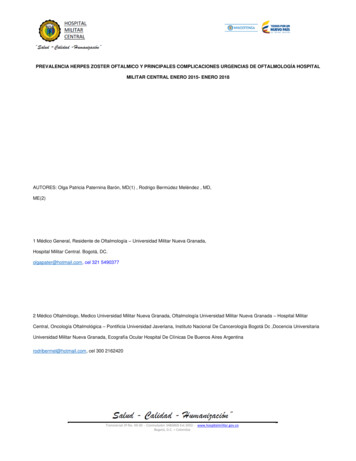



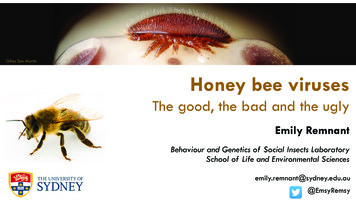


![3184 PPT [Read-Only] - Texas Municipal Courts Education Center](/img/38/00-collins-binder-law-update.jpg)
